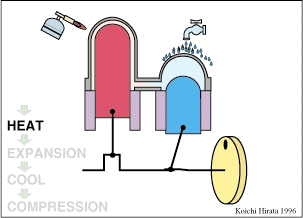
 HEATING HEATING
Let's start from top dead center of the hot piston. The
hot piston moves to the upper part of the cylinder and the cold piston
moves to the lower part of the cylinder during the first 90 degrees of
revolution. The working air is moved from the cold space to the hot space.
And the pressure in the engine is increased.
EXPANSION
During the next 90 degrees of revolution, the two pistons
both move the lower part accepting the air pressure. The engine gets its
power during this portion of its cycle.
COOLING
The crankshaft revolves by power stored in the flywheel
for the next 90 degrees. The hot piston moves to the lower part and the
cold piston moves to the upper part. The air is moved from the hot space
to the cold space. And the pressure in the engine is decreased.
COMPRESSION
The two pistons are moved to upper part by the contraction
of the air during the next 90 degrees. The engine also gets power during
this portion of its cycle. The two piston type Stirling engine then repeats
this cycle. |